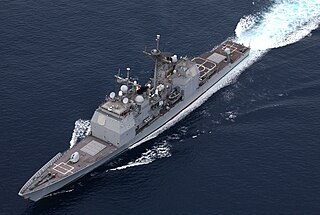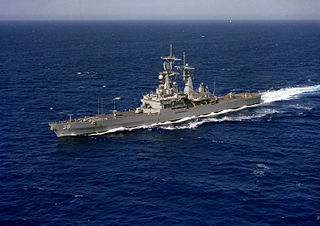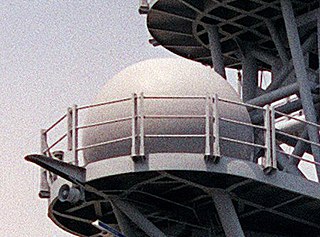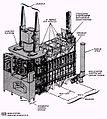
The RUR-5 ASROC is an all-weather, all sea-conditions anti-submarine missile system. Developed by the United States Navy in the 1950s, it was deployed in the 1960s, updated in the 1990s, and eventually installed on over 200 USN surface ships, specifically cruisers, destroyers, and frigates. The ASROC has been deployed on scores of warships of many other navies, including Canada, Germany, Italy, Japan, the Republic of China, Greece, Pakistan and others.

The Aegis Combat System is an American integrated naval weapons system developed by the Missile and Surface Radar Division of RCA, and now produced by Lockheed Martin. It uses powerful computer and radar technology to track and guide weapons to destroy enemy targets.

USS Long Beach (CLGN-160/CGN-160/CGN-9) was a nuclear-powered guided missile cruiser in the United States Navy and the world's first nuclear-powered surface combatant. She was the third Navy ship named after the city of Long Beach, California.

The Spruance-class destroyer was developed by the United States to replace the many World War II–built Allen M. Sumner- and Gearing-class destroyers and was the primary destroyer built for the U.S. Navy during the 1970s and 1980s. It was named in honour of United States Navy Admiral Raymond A. Spruance, who successfully led major naval battles in the Asiatic-Pacific Theater during World War II such as the Battle of Midway and Battle of the Philippine Sea.

The Charles F. Adams class is a ship class of 29 guided missile destroyers (DDG) built between 1958 and 1967. Twenty-three destroyers were built for the United States Navy, three for the Royal Australian Navy, and three for the West German Bundesmarine. The design of these ships was based on that of Forrest Sherman-class destroyers, but the Charles F. Adams class were the first class designed to serve as guided missile destroyers. 19 feet (5.8 m) of length was added to the center of the design of the Forrest Sherman class to carry the ASROC launcher. The Charles F. Adams-class destroyers were the last steam turbine-powered destroyers built for the U.S. Navy. Starting with the later Spruance-class destroyers, all U.S. Navy destroyers have been powered by gas turbines. Some of the destroyers of the Charles F. Adams class served during the blockade of Cuba in 1962 and during the Vietnam War. Destroyers of the Royal Australian Navy served during the Vietnam War and Gulf War.

The Ticonderoga class of guided-missile cruisers is a class of warships in the United States Navy, first ordered and authorized in the 1978 fiscal year. The class uses passive phased-array radar and was originally planned as a class of destroyers. However, the increased combat capability offered by the Aegis Combat System and the AN/SPY-1 radar system, together with the capability of operating as a flagship, were used to justify the change of the classification from DDG to CG shortly before the keels were laid down for Ticonderoga and Yorktown.

The Virginia-class nuclear guided-missile cruisers, also known as the CGN-38 class, were a series of four double-ended nuclear-powered guided-missile cruisers commissioned in the late 1970s to 1980, which served in the United States Navy until the mid-to-late 1990s. They were the final class of nuclear-powered cruisers completed and the last ships ordered as Destroyer Leaders under the pre-1975 classification system.

USS California (CGN-36), the lead ship of the California-class of nuclear-powered guided missile cruisers, was the sixth warship of the United States Navy to be named for the State of California.

Mark 32 Surface Vessel Torpedo Tubes is a torpedo launching system designed for the United States Navy.

The Mark 13 guided missile launching system (GMLS) is a single-arm missile launcher designed for use on frigates and other military vessels. Because of its distinctive single-armed design, the Mark 13 is often referred to as the "one-armed bandit".

The California class was a pair of two nuclear-powered guided missile cruisers operated by the United States Navy between 1974 and 1998. Other than their nuclear power supply and lack of helicopter hangars, ships of the California class were comparable to other guided missile cruisers of their era, such as the Belknap class. The class was built as a follow-up to the nuclear-powered Long Beach, Bainbridge, and Truxtun classes. Like all of the nuclear cruisers, which could steam for years between refuelings, the California class was designed in part to provide high endurance escort for the navy's nuclear aircraft carriers, which were often limited in range due to their conventionally powered escorts continuously needing to be refueled.

The Tartar Guided Missile Fire Control System is an air defense system developed by the United States Navy to defend warships from air attack. Since its introduction the system has been improved and sold to several United States allies.

The 127 mm (5")/54 caliber lightweight gun is a U.S. naval artillery gun mount consisting of a 127 mm (5 in) L54 Mark 19 gun on the Mark 45 mount. It was designed and built by United Defense, a company later acquired by BAE Systems Land & Armaments, which continued manufacture.

New Threat Upgrade (NTU) was a United States Navy program to improve and modernize the capability of existing cruisers and destroyers equipped with Terrier and Tartar anti-aircraft systems, keeping them in service longer. It was a key component of then-President Ronald Reagan's 600-ship Navy plan.

The Belknap-class cruiser was a class of single-ended guided missile cruisers built for the United States Navy during the 1960s. They were originally designated as DLG frigates, but in the 1975 fleet realignment, they were reclassified as guided missile cruisers (CG).

AN/SPQ-9A,, is a United States Navy multi-purpose surface search & fire control radar used with the Mk-86 gun fire-control system. It is a two dimensional surface-search radar, meaning it provides only range and bearing but not elevation. It is intended primarily to detect & track targets at sea level, on the surface of the water for either gun fire engagement or navigation. It can however, also detect and track low altitude air targets.

The RIM-66 Standard MR (SM-1MR/SM-2MR) is a medium-range surface-to-air missile (SAM), with a secondary role as anti-ship missile, originally developed for the United States Navy (USN). A member of the Standard Missile family of weapons, the SM-1 was developed as a replacement for the RIM-2 Terrier and RIM-24 Tartar that were deployed in the 1950s on a variety of USN ships. The RIM-67 Standard (SM-1ER/SM-2ER) is an extended range version of this missile with a solid rocket booster stage.

The RIM-67 Standard ER (SM-1ER/SM-2ER) is an extended range surface-to-air missile (SAM) and anti ship missile originally developed for the United States Navy (USN). The RIM-67 was developed as a replacement for the RIM-8 Talos, a 1950s system deployed on a variety of USN ships, and eventually replaced the RIM-2 Terrier as well, since it was of a similar size and fitted existing Terrier launchers and magazines. The RIM-66 Standard MR was essentially the same missile without the booster stage, designed to replace the RIM-24 Tartar. The RIM-66/67 series thus became the US Navy's universal SAM system, hence the "Standard Missile" moniker.

The Mark 41 Vertical Launching System is a shipborne missile canister launching system which provides a rapid-fire launch capability against hostile threats. The Vertical Launch System (VLS) concept was derived from work on the Aegis Combat System.

JS Sawagiri (DD-157) is an Asagiri-class destroyer of the Japan Maritime Self-Defense Force.


















